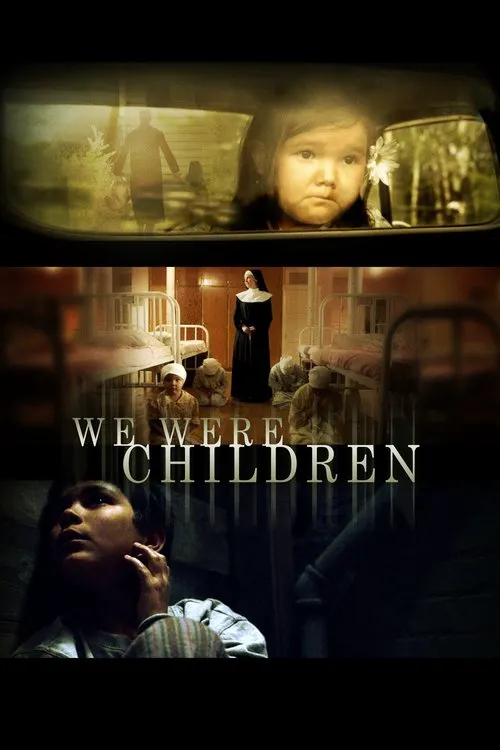We Were Children

Plot
We Were Children tells the devastating true story of the Canadian government's forced assimilation of its First Nations children through the network of residential schools, established in the late 19th century and operating until 1996. The documentary delves into the personal experiences of Glen Anaquod and Lyna Hart, two individuals who underwent this traumatic ordeal. Their testimonies shed light on the brutal realities of life within these institutions, where the native culture and identity were systematically erased. As the film begins, Glen Anaquod recounts the memories of his early years. Glen was just 4 years old when he was forcibly taken from his home in Saskatchewan to attend the Beauval Indian Residential School in northern Saskatchewan. This marked the beginning of a painful and transformative journey for Glen and countless others like him. Glen's family, like many others, had initially been coerced into sending their children to the school, promised that this would lead to a better education and opportunities for their little ones. However, what awaited them was nothing short of institutionalized trauma. In the school, Glen was subjected to inhumane physical and psychological abuse. Children as young as him were forced to endure whippings, beatings, and even physical violence from their instructors and older students. The once-vibrant cultural practices, storytelling, and languages of their ancestors were silenced, deemed 'pagan' and incompatible with modern Christian values. This complete erasure of their identity would forever alter the course of Glen's life, rendering him uncertain of his place in the world. Lyna Hart, a Cree woman, shares an equally disturbing account of her life within the church-run residential school in Norway House, Manitoba. At a similarly tender age, she too experienced the devastating effects of the assimilation policy. Lyna's narrative highlights the psychological trauma inflicted upon her by the nuns and priests who administered brutal punishments and humiliated her for her native roots. This relentless suppression of her culture pushed her to question her native identity and the place she belonged in the world. The experiences of Glen and Lyna serve as a window into a broader, darker truth: that this was a state-orchestrated effort to erase First Nations identity, culture, and history. This was, in the words of Duncan Campbell Scott, a top official in the Indian Affairs branch, an endeavor aimed at 'killing the Indian in the child.' The policy of forced assimilation was designed to integrate the native peoples into Canadian society by suppressing their native languages and culture. This 'cultural annihilation,' as historian John S. Milloy calls it, had far-reaching consequences for the indigenous peoples and Canadian society as a whole. One critical aspect of the documentary that underscores the pervasive harm inflicted on the indigenous communities is the intergenerational trauma that this policy generated. The film reveals how the pain, anger, and feelings of isolation that Glen and Lyna continue to feel today are not unique to their experiences but rather reflective of a far-reaching legacy of cultural destruction and trauma that echoes across generations. For many indigenous peoples in Canada, their identity is deeply intertwined with their ancestral lands, languages, and traditions. The systematic suppression of these aspects of their identity has left in its wake a legacy of intergenerational suffering and pain. One of the standout aspects of the film is its ability to convey the full extent of the emotional and psychological impact on indigenous survivors. Glen's struggles with addiction and his deep-seated anger, as well as Lyna's ongoing battle with the physical and emotional scars of her time at the residential school, demonstrate the lasting impact of this system on individuals and families. In a society where their native culture and identities have been all but erased, it is little wonder that so many First Nations people struggle with feelings of disconnection and marginalization. The filmmakers skillfully juxtapose the personal testimonies with a broader historical context, shedding light on the dark underbelly of Canada's nation-building project. As the documentary progresses, the narrative reveals the extent to which the Canadian government was complicit in this system. The schools operated under the tacit consent, if not direct encouragement, of successive governments. They were seen as necessary tools in the broader project of nation-building and the 'Canadianization' of its diverse indigenous populations. In 'We Were Children,' Glen and Lyna's narratives become the foundation upon which we can begin to understand the complexities of Canadian history and the interplay between the state and its indigenous peoples. Their testimonies, and those of countless others like them, are a searing indictment of a system designed to erase the cultural identity of a people. It serves as a powerful testament to the resilience and strength of the indigenous peoples of Canada and underscores the urgent need for a more complete understanding of this painful chapter of Canadian history. By offering a platform for indigenous survivors to tell their stories, the filmmakers hope to honor the memory of those who suffered in silence for too long. In doing so, this documentary also reminds us that healing and reconciliation are not solely the business of the past but urgent necessities that require sustained attention and action today. By listening to Glen and Lyna's stories and acknowledging this painful history, we begin to confront the darkest corners of our nation's conscience and, in doing so, lay the groundwork for a more inclusive and compassionate understanding of the complex history of Canada and its indigenous peoples.
Reviews
Recommendations



